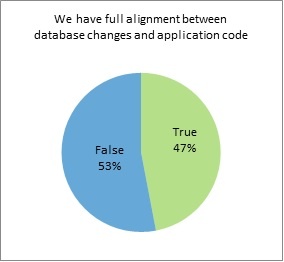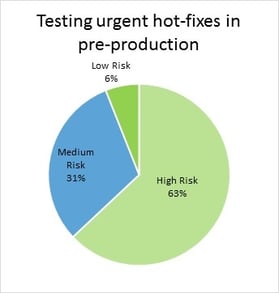Developers are under increased pressure to rapidly implement necessary changes to the database in order to rectify bugs and meet customer demands. Ensuring the safe release of an applications starts with automating the database. First though, we’ll need to accurately take stock of all the involved risks and database deployment automation obstacles in order to make sure they are duly mitigated and avoided. Consider the following:
The Risk of Introducing Direct Changes
The need for increased agility often leads developers to introduce changes directly to the QA environment. This is done to save time and to ready changes for deployment more quickly – but the approach is not without risk. According to more than 80 percent of IT professionals surveyed in a study conducted by DBmaestro, introducing changes directly to the QA environment is considered risky.
Despite this, 43 percent affirm that they still introduce changes directly to the QA environment, knowing that such changes could adversely affect things later in the development pipeline.
 Having no alignment between database changes and application code – from a source control perspective – is a problem that nearly all IT professionals (nearly 100% of respondents) associate with risk. Yet only 47 percent of IT professionals surveyed say that they have full alignment between database changes and application code.
Having no alignment between database changes and application code – from a source control perspective – is a problem that nearly all IT professionals (nearly 100% of respondents) associate with risk. Yet only 47 percent of IT professionals surveyed say that they have full alignment between database changes and application code.
That means more than half of respondents are faced with risks associated with this misalignment between database changes and their application code. This can create serious problems, including application crashes that cost hundreds of thousands of dollars (or more) to rectify.
Overcoming Database Deployment Automation Obstacles
There’s a simple solution to overcoming database deployment automation obstacles: database lifecycle management (DLM). DLM solutions utilize a simple check-in, check-out process, allowing development teams to leverage a single source of truth and prevent out-of-process changes, avoiding changes that may override or revert important changes introduced by another team or developer.
In addition, database enforced source control solutions provide complete, trusted source control for both database objects and data. It also provides complete history tracking by merging development information and change history from several branches or servers to create a single and trusted source of control.
The Quick Fix
With today’s rapid development cycles and the need to be increasingly agile, introducing rapid changes and quick fixes to rectify errors is commonplace in the database development world. It’s not all that surprising that many development teams are forced to test urgent hot fixes in pre-production.
 More than 90 percent of IT professionals surveyed associate the practice of testing urgent hot-fixes in pre-production with risks, yet among them, 53 percent do just that.
More than 90 percent of IT professionals surveyed associate the practice of testing urgent hot-fixes in pre-production with risks, yet among them, 53 percent do just that.
By leveraging a database merge and build automation solution combined with database release automation, developers can take advantage of a highly effective database safety net that ensures safe migration to production.
Merge and build automation processes are designed to meet the needs of today’s IT professionals. These solutions can be so effective that organizations taking advantage of true automation capabilities can realize up to a 95 percent reduction in deployment costs.
Often, such issues aren’t obvious until the changes have been deployed, which can cost companies hundreds of thousands of dollars to rectify. (Not to mention application downtime that can damage customer satisfaction.) By achieving database deployment automation, you’ll break down the silos that exist between development and operations, enabling your organization to leverage the same continuous delivery best practices for your database that you’re already using for your applications.
What’s Standing In the Way of DevOps for Database
Implementing DevOps for the database is the ideal goal for most development teams. But the path to achieving this goal is not without obstacles. 62 percent of survey respondents say that unstructured processes prevent them from implementing DevOps for the database, while 42 percent say that budget constraints are a primary obstacle.
While these challenges may seem insurmountable, the reality is that development teams face increasing pressure to build more efficiency into the development cycle, while simultaneously mitigating risks. Because automation has the reputation of not being trustworthy, manual processes are used to reduce the risk of blindly automating processes without effective tools.
However, these same manual processes slow down the development cycle and introduce risks of their own. Once IT departments overcome database deployment automation obstacles, they will be able to automate processes safely and efficiently.
The Solution
Only a complete database continuous delivery solution can effectively alleviate these concerns and bridge the silos between development and operations, providing the first opportunity for true database deployment automation.
Using a simple, highly effective set of solutions that leverage logic and intuitive workflows will result in dramatic reductions in development costs. This is accomplished while simultaneously streamlining workflows and enhancing collaboration across different IT teams and departments, breaking down the barriers of database deployment process.





